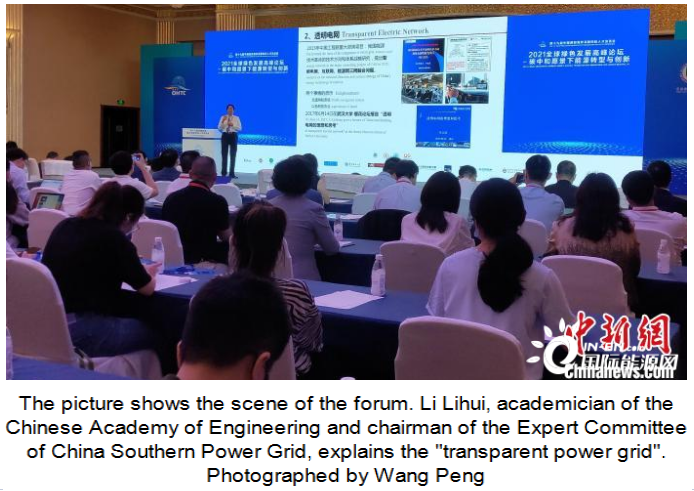Academician Li Lihui: Under the vision of carbon neutrality, how does China carry out its energy transition?
"China needs to build a clean, low-carbon, safe and efficient energy system to achieve its'dual carbon' goal, and build a new power system with new energy as the mainstay." From September 6 to 8, focus on "Energy Transformation under the Vision of Carbon Neutrality" The 2021 Global Green Development Summit Forum of "and Innovation" was held in Chengdu. Zhou Xiaoxin, academician of the Chinese Academy of Sciences and honorary dean of the China Electric Power Research Institute, proposed "two constructions" at the forum.

According to data, as of the end of 2020, China's coal power installed capacity is about 1.095 billion kilowatts, accounting for about 49.8% of the total installed capacity, historically within 50%, but due to high energy density, coal power generation still accounts for 65% about. Zhou Xiaoxin said that according to analysis, China's fossil energy power generation will be basically zero by 2060, and wind power, solar energy, biomass energy, hydropower, and nuclear power will account for 99.5%, otherwise carbon neutrality will not be achieved.
In fact, vigorously developing renewable energy and green energy is the main path for China to achieve carbon neutrality mentioned by many experts. Among them, the development of green energy in western China has attracted much attention.
"The development of wind and photovoltaic resources in western China is one of China's major projects to achieve the goal of'dual carbon'." Tang Yuan, a researcher at the China Policy Research Institute, pointed out that China is very rich in wind and photovoltaic resources, and is owned in western regions such as Qinghai, Xinjiang, Gansu, and Tibet. Many wind and wind resources of hundreds of millions of kilowatts are available for development and utilization. “For example, there are 110,000 square kilometers of desert in Qinghai’s Qaidam Basin that can be used as wind and wind resources, and the development cost is very low. Electricity is within RMB 0.2."
Tang Yuan emphasized that the development and construction of a number of super-large-scale wind and solar power generation bases in western China using wind and solar resources, replacing coal power with green power, forming a power supply pattern dominated by renewable energy, is a fundamental change in China’s use of coal. The only way out for the main energy supply pattern.
"To implement carbon emission reduction, in addition to reducing carbon dioxide emissions through energy transformation, we also need to absorb carbon dioxide in the air." Tang Yuan said, therefore, China also needs to plant large-scale afforestation and form carbon sink forests, considering that ordinary forests are not economical. For sustainable development, it is recommended to use barren hills and wastelands to develop oil-bearing energy forests. “The barren hills and wastelands can be used to form carbon sink forests, but also to increase the supply of biomass oil and reduce oil imports. The economy is also considerable.”
Another major focus of the energy transition is the transformation of the power system. In this regard, Li Lihui, academician of the Chinese Academy of Engineering and chairman of the Expert Committee of China Southern Power Grid, proposed that China will implement pan-electrification in the future and use electricity to produce hydrogen and methanol instead of fossil energy. This requires improving the digitalization, informatization and intelligence of the power system and building a "transparent power grid."
"What does the'transparent grid' want to achieve? That is, the entire grid must be fully visible, controllable, and controllable. It must be deeply integrated with the grid power system through information technology, integration technology, communication technology, sensor technology, control theory and control technology, etc., Realize the free data collection, data storage, data acquisition, and intelligent analysis of the power grid." Li Lixi further explained.
In terms of power storage technology, Guan Xiaohong, an academician of the Chinese Academy of Sciences and a professor at Xi’an Jiaotong University, said that the traditional primary energy is converted into electrical energy to connect to the grid, but there is no large-scale economic power storage technology that must be an instantaneous balance of supply and demand. System, this poses a fundamental challenge to the use of renewable energy with high uncertainty, so the phenomenon of abandoning wind, light, and water is very serious.
“Hydrogen energy has the advantages of clean, renewable, and high energy density. Hydrogen fuel cells are a better storage direction. Hydrogen energy preparation and storage and transportation technologies are on the eve of the technological revolution.” Guan Xiaohong said, so China needs Special attention is paid to the breakthrough photocatalytic hydrogen production technology, hydrogen storage technology under normal temperature and pressure, and hydrogen fuel cell technology.
News source: China News Network



 Weicax
Weicax